Vodafone PLC: A Financial Analysis of Gearing and Dividend Policies
VerifiedAdded on 2019/12/03
|18
|3073
|141
Report
AI Summary
This report provides a financial analysis of Vodafone PLC, focusing on its gearing and dividend policies. The study examines the company's capital structure, utilizing gearing ratios to assess the proportion of debt and equity. It delves into Vodafone's dividend policy, evaluating payout ratios and their impact on shareholder returns. The analysis incorporates relevant financial theories, including traditional gearing theory, Modigliani and Miller's theories, and the static trade-off theory, to provide a comprehensive understanding of Vodafone's financial strategies. The report highlights fluctuations in profitability and their effect on dividend stability, ultimately recommending improvements in operational activities and dividend policies to enhance shareholder value and financial stability. The analysis is supported by data from annual reports and industry insights, offering practical recommendations for Vodafone PLC's financial management.

Financial
management
1
management
1
Paraphrase This Document
Need a fresh take? Get an instant paraphrase of this document with our AI Paraphraser
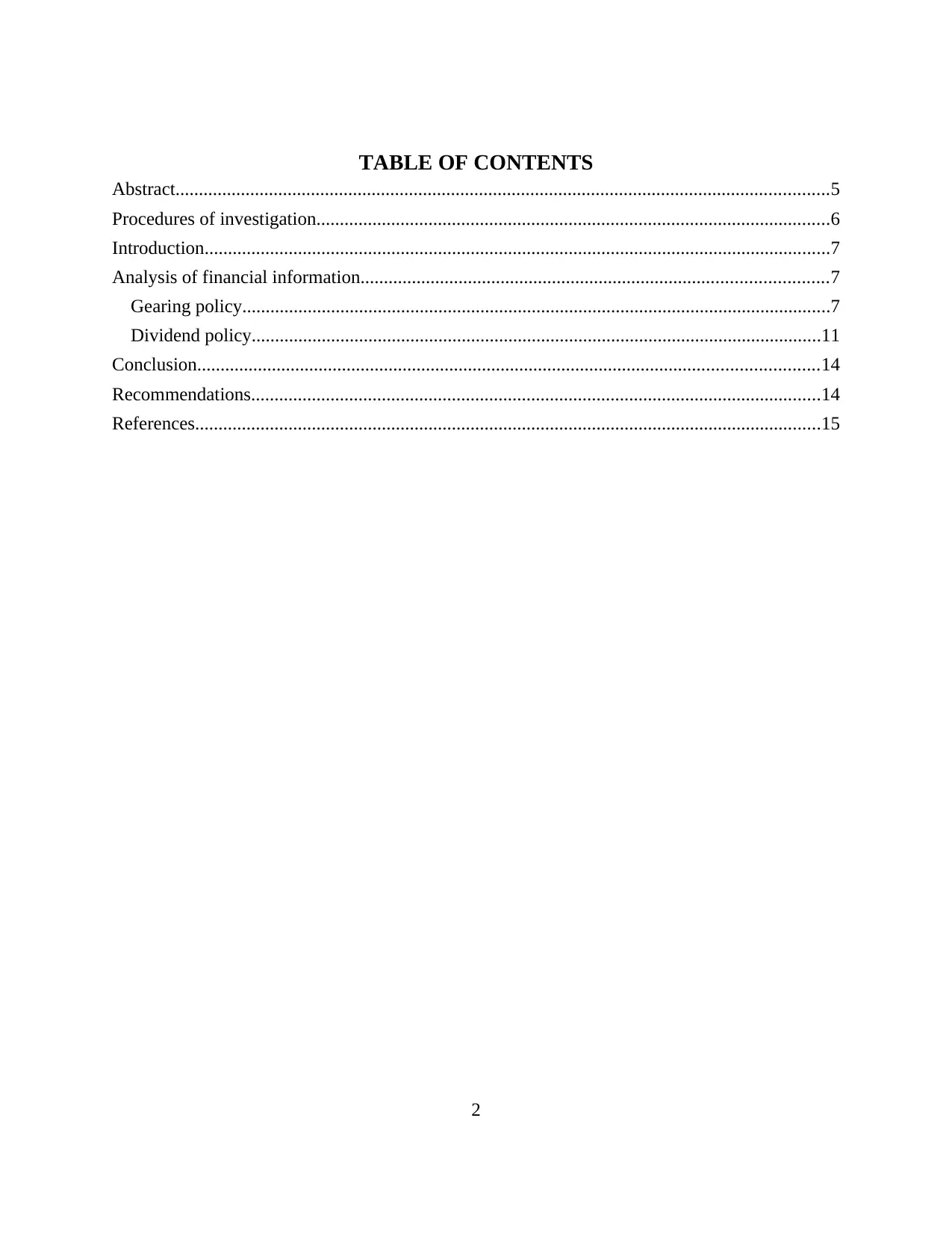
TABLE OF CONTENTS
Abstract............................................................................................................................................5
Procedures of investigation..............................................................................................................6
Introduction......................................................................................................................................7
Analysis of financial information....................................................................................................7
Gearing policy..............................................................................................................................7
Dividend policy..........................................................................................................................11
Conclusion.....................................................................................................................................14
Recommendations..........................................................................................................................14
References......................................................................................................................................15
2
Abstract............................................................................................................................................5
Procedures of investigation..............................................................................................................6
Introduction......................................................................................................................................7
Analysis of financial information....................................................................................................7
Gearing policy..............................................................................................................................7
Dividend policy..........................................................................................................................11
Conclusion.....................................................................................................................................14
Recommendations..........................................................................................................................14
References......................................................................................................................................15
2

INDEX OF TABLES
Table 1: Gearing ratios of Vodafone Plc.........................................................................................8
Table 2: Dividend ratios of Vodafone Plc.....................................................................................11
Table 3: Payout ratio of Vodafone Plc...........................................................................................12
3
Table 1: Gearing ratios of Vodafone Plc.........................................................................................8
Table 2: Dividend ratios of Vodafone Plc.....................................................................................11
Table 3: Payout ratio of Vodafone Plc...........................................................................................12
3
⊘ This is a preview!⊘
Do you want full access?
Subscribe today to unlock all pages.

Trusted by 1+ million students worldwide
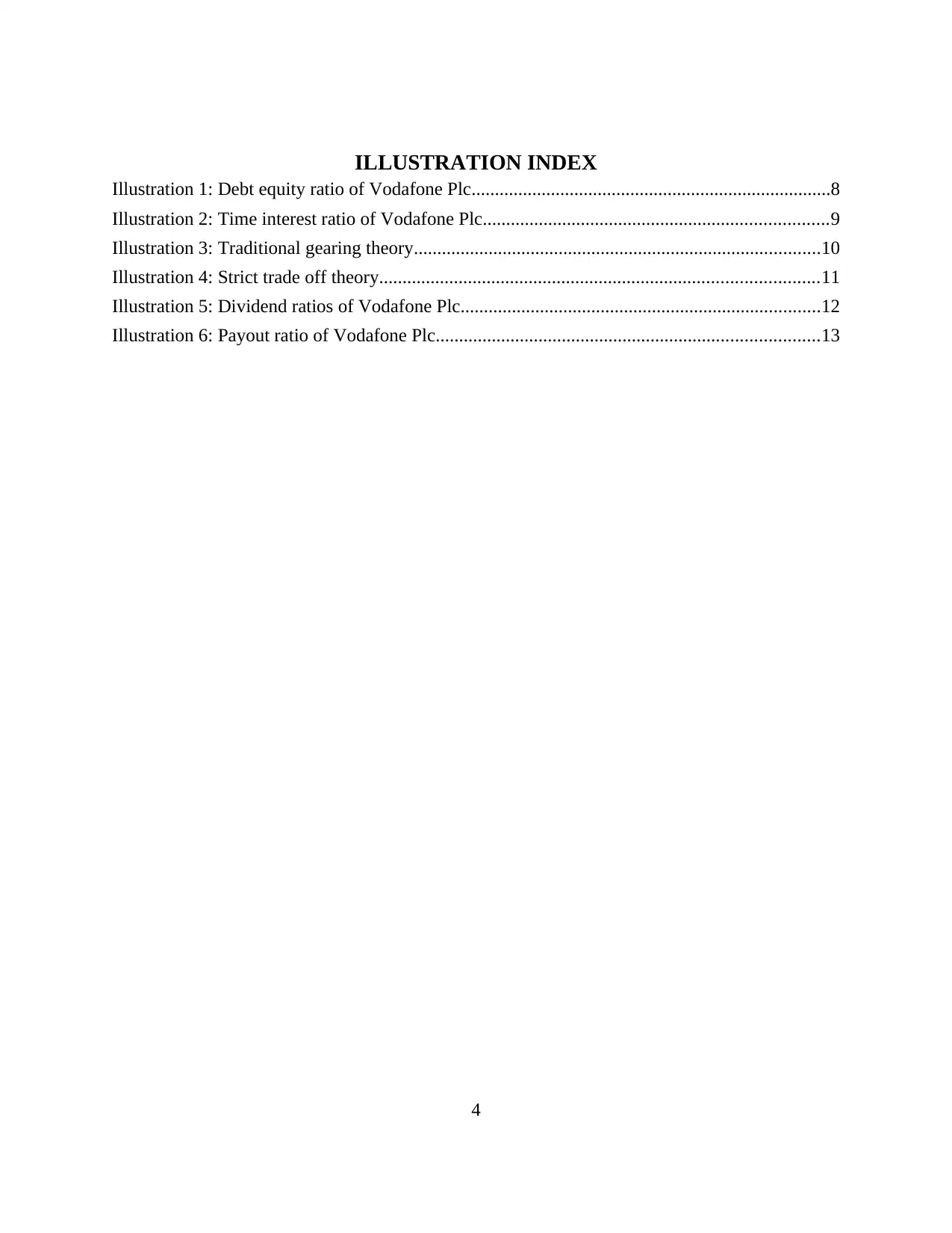
ILLUSTRATION INDEX
Illustration 1: Debt equity ratio of Vodafone Plc.............................................................................8
Illustration 2: Time interest ratio of Vodafone Plc..........................................................................9
Illustration 3: Traditional gearing theory.......................................................................................10
Illustration 4: Strict trade off theory..............................................................................................11
Illustration 5: Dividend ratios of Vodafone Plc.............................................................................12
Illustration 6: Payout ratio of Vodafone Plc..................................................................................13
4
Illustration 1: Debt equity ratio of Vodafone Plc.............................................................................8
Illustration 2: Time interest ratio of Vodafone Plc..........................................................................9
Illustration 3: Traditional gearing theory.......................................................................................10
Illustration 4: Strict trade off theory..............................................................................................11
Illustration 5: Dividend ratios of Vodafone Plc.............................................................................12
Illustration 6: Payout ratio of Vodafone Plc..................................................................................13
4
Paraphrase This Document
Need a fresh take? Get an instant paraphrase of this document with our AI Paraphraser
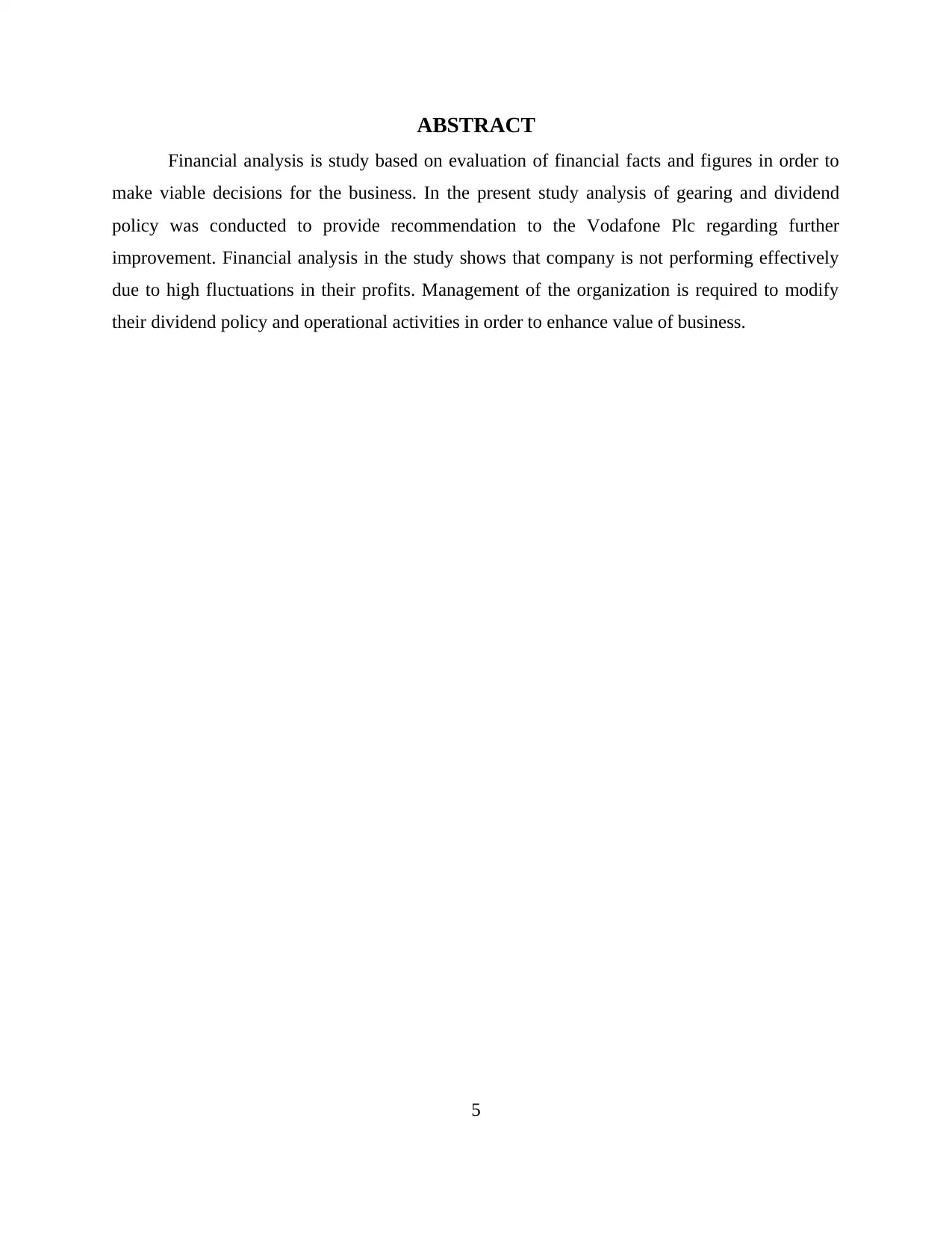
ABSTRACT
Financial analysis is study based on evaluation of financial facts and figures in order to
make viable decisions for the business. In the present study analysis of gearing and dividend
policy was conducted to provide recommendation to the Vodafone Plc regarding further
improvement. Financial analysis in the study shows that company is not performing effectively
due to high fluctuations in their profits. Management of the organization is required to modify
their dividend policy and operational activities in order to enhance value of business.
5
Financial analysis is study based on evaluation of financial facts and figures in order to
make viable decisions for the business. In the present study analysis of gearing and dividend
policy was conducted to provide recommendation to the Vodafone Plc regarding further
improvement. Financial analysis in the study shows that company is not performing effectively
due to high fluctuations in their profits. Management of the organization is required to modify
their dividend policy and operational activities in order to enhance value of business.
5

PROCEDURES OF INVESTIGATION
For the accomplishment of present study information has been obtained from
consultation of documents such as annual reports, industry report and online articles. Information
obtained from these sources is relevant and reliable to satisfy the objective of the study.
6
For the accomplishment of present study information has been obtained from
consultation of documents such as annual reports, industry report and online articles. Information
obtained from these sources is relevant and reliable to satisfy the objective of the study.
6
⊘ This is a preview!⊘
Do you want full access?
Subscribe today to unlock all pages.

Trusted by 1+ million students worldwide
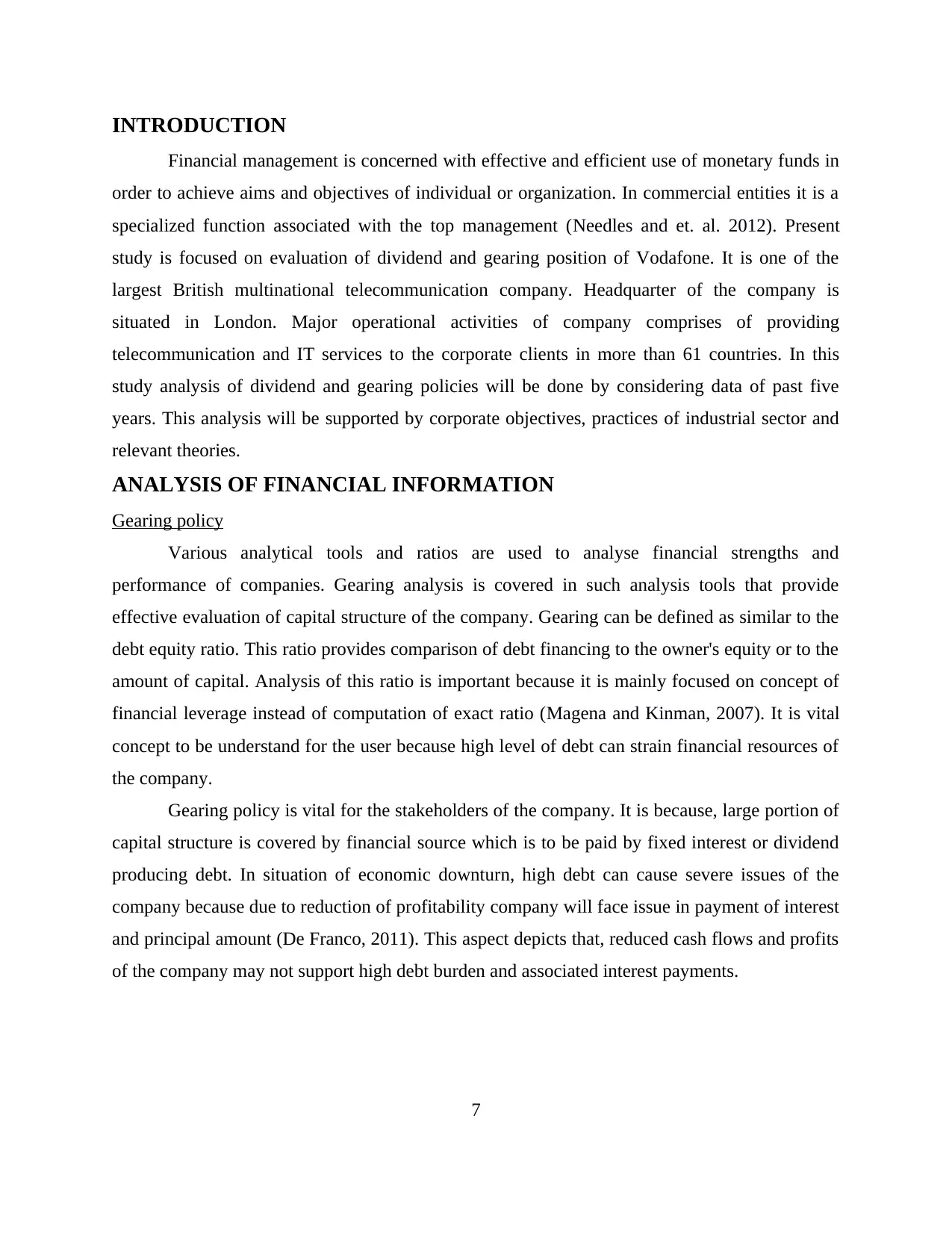
INTRODUCTION
Financial management is concerned with effective and efficient use of monetary funds in
order to achieve aims and objectives of individual or organization. In commercial entities it is a
specialized function associated with the top management (Needles and et. al. 2012). Present
study is focused on evaluation of dividend and gearing position of Vodafone. It is one of the
largest British multinational telecommunication company. Headquarter of the company is
situated in London. Major operational activities of company comprises of providing
telecommunication and IT services to the corporate clients in more than 61 countries. In this
study analysis of dividend and gearing policies will be done by considering data of past five
years. This analysis will be supported by corporate objectives, practices of industrial sector and
relevant theories.
ANALYSIS OF FINANCIAL INFORMATION
Gearing policy
Various analytical tools and ratios are used to analyse financial strengths and
performance of companies. Gearing analysis is covered in such analysis tools that provide
effective evaluation of capital structure of the company. Gearing can be defined as similar to the
debt equity ratio. This ratio provides comparison of debt financing to the owner's equity or to the
amount of capital. Analysis of this ratio is important because it is mainly focused on concept of
financial leverage instead of computation of exact ratio (Magena and Kinman, 2007). It is vital
concept to be understand for the user because high level of debt can strain financial resources of
the company.
Gearing policy is vital for the stakeholders of the company. It is because, large portion of
capital structure is covered by financial source which is to be paid by fixed interest or dividend
producing debt. In situation of economic downturn, high debt can cause severe issues of the
company because due to reduction of profitability company will face issue in payment of interest
and principal amount (De Franco, 2011). This aspect depicts that, reduced cash flows and profits
of the company may not support high debt burden and associated interest payments.
7
Financial management is concerned with effective and efficient use of monetary funds in
order to achieve aims and objectives of individual or organization. In commercial entities it is a
specialized function associated with the top management (Needles and et. al. 2012). Present
study is focused on evaluation of dividend and gearing position of Vodafone. It is one of the
largest British multinational telecommunication company. Headquarter of the company is
situated in London. Major operational activities of company comprises of providing
telecommunication and IT services to the corporate clients in more than 61 countries. In this
study analysis of dividend and gearing policies will be done by considering data of past five
years. This analysis will be supported by corporate objectives, practices of industrial sector and
relevant theories.
ANALYSIS OF FINANCIAL INFORMATION
Gearing policy
Various analytical tools and ratios are used to analyse financial strengths and
performance of companies. Gearing analysis is covered in such analysis tools that provide
effective evaluation of capital structure of the company. Gearing can be defined as similar to the
debt equity ratio. This ratio provides comparison of debt financing to the owner's equity or to the
amount of capital. Analysis of this ratio is important because it is mainly focused on concept of
financial leverage instead of computation of exact ratio (Magena and Kinman, 2007). It is vital
concept to be understand for the user because high level of debt can strain financial resources of
the company.
Gearing policy is vital for the stakeholders of the company. It is because, large portion of
capital structure is covered by financial source which is to be paid by fixed interest or dividend
producing debt. In situation of economic downturn, high debt can cause severe issues of the
company because due to reduction of profitability company will face issue in payment of interest
and principal amount (De Franco, 2011). This aspect depicts that, reduced cash flows and profits
of the company may not support high debt burden and associated interest payments.
7
Paraphrase This Document
Need a fresh take? Get an instant paraphrase of this document with our AI Paraphraser
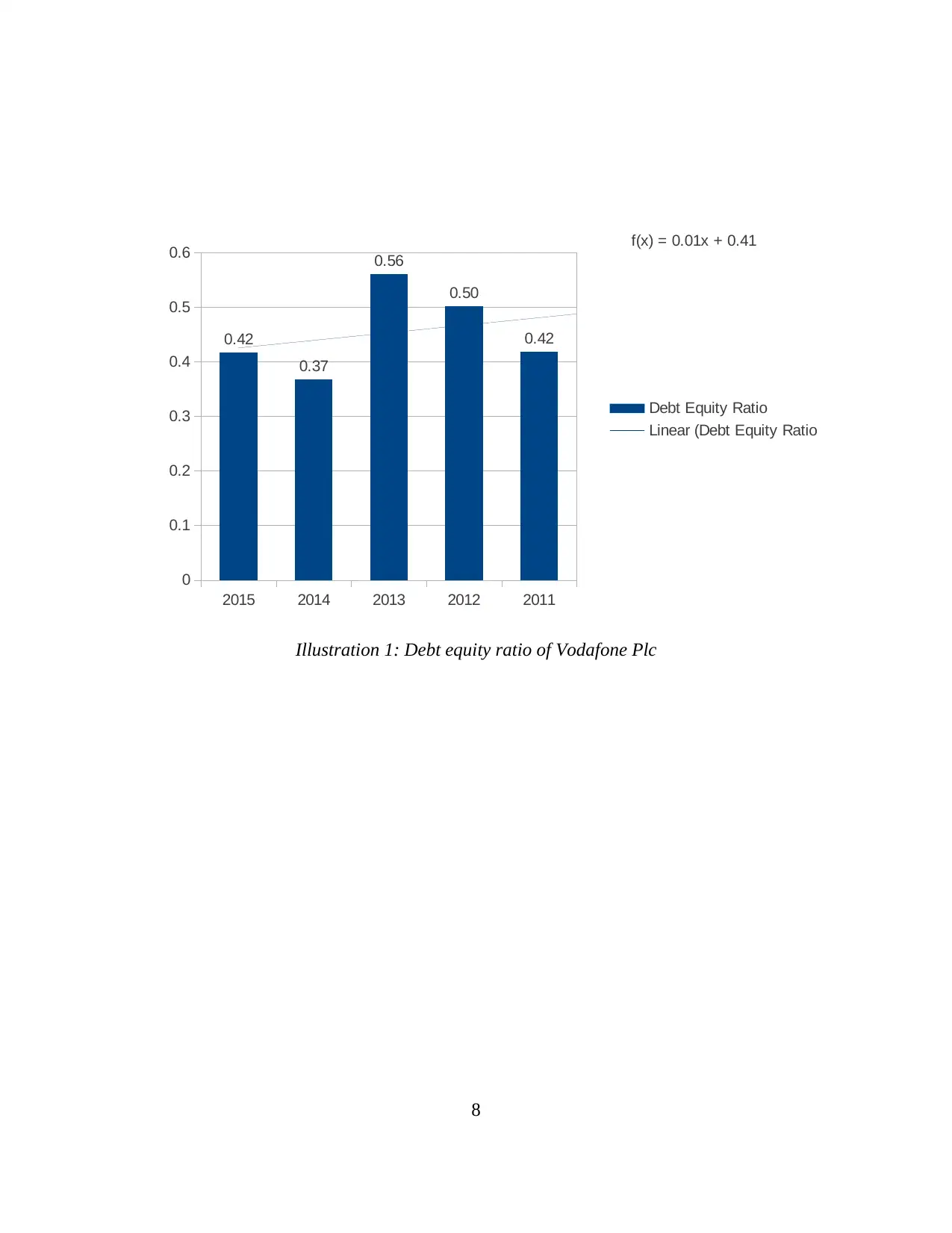
8
2015 2014 2013 2012 2011
0
0.1
0.2
0.3
0.4
0.5
0.6
0.42
0.37
0.56
0.50
0.42
f(x) = 0.01x + 0.41
Debt Equity Ratio
Linear (Debt Equity Ratio)
Illustration 1: Debt equity ratio of Vodafone Plc
2015 2014 2013 2012 2011
0
0.1
0.2
0.3
0.4
0.5
0.6
0.42
0.37
0.56
0.50
0.42
f(x) = 0.01x + 0.41
Debt Equity Ratio
Linear (Debt Equity Ratio)
Illustration 1: Debt equity ratio of Vodafone Plc
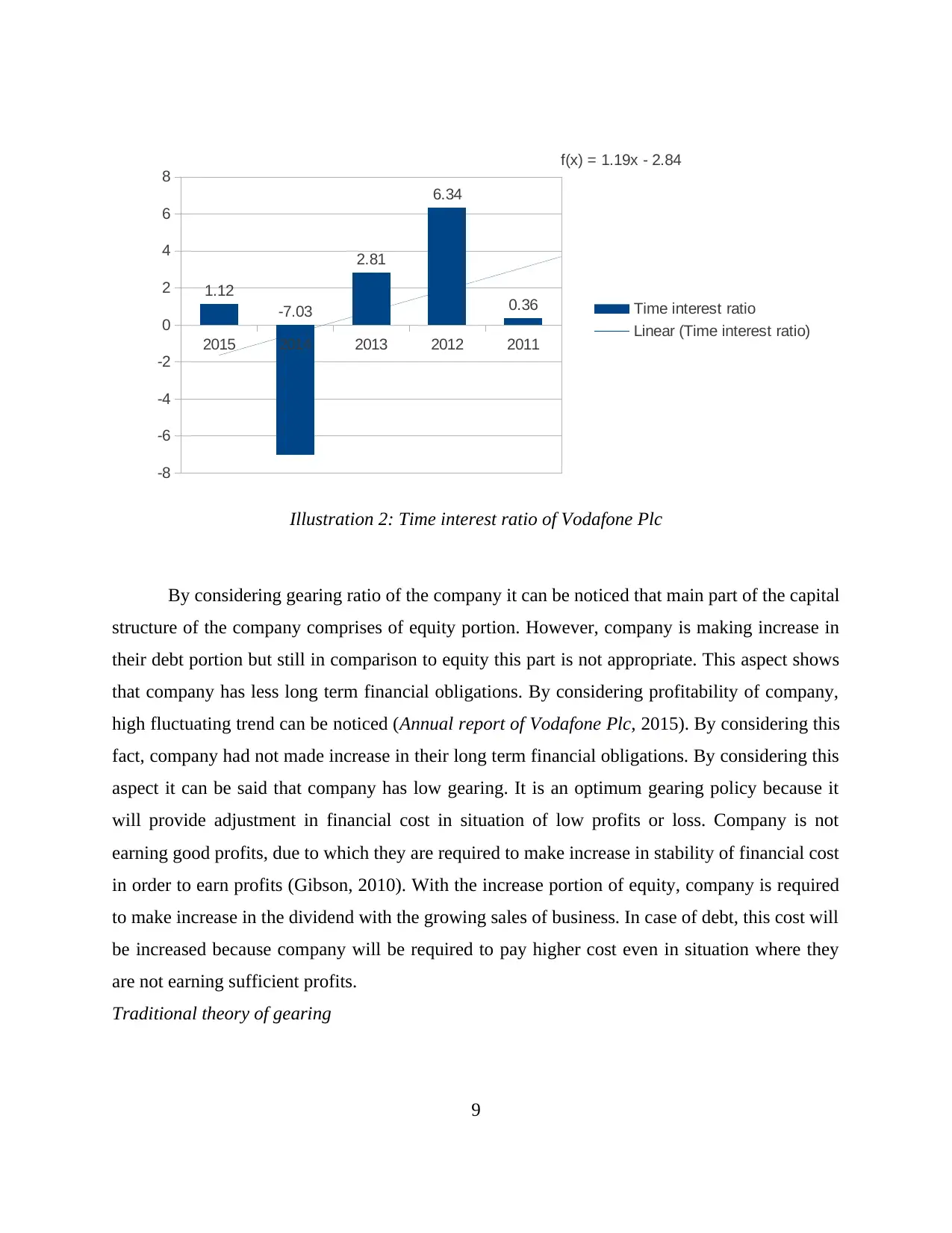
By considering gearing ratio of the company it can be noticed that main part of the capital
structure of the company comprises of equity portion. However, company is making increase in
their debt portion but still in comparison to equity this part is not appropriate. This aspect shows
that company has less long term financial obligations. By considering profitability of company,
high fluctuating trend can be noticed (Annual report of Vodafone Plc, 2015). By considering this
fact, company had not made increase in their long term financial obligations. By considering this
aspect it can be said that company has low gearing. It is an optimum gearing policy because it
will provide adjustment in financial cost in situation of low profits or loss. Company is not
earning good profits, due to which they are required to make increase in stability of financial cost
in order to earn profits (Gibson, 2010). With the increase portion of equity, company is required
to make increase in the dividend with the growing sales of business. In case of debt, this cost will
be increased because company will be required to pay higher cost even in situation where they
are not earning sufficient profits.
Traditional theory of gearing
9
2015 2014 2013 2012 2011
-8
-6
-4
-2
0
2
4
6
8
1.12
-7.03
2.81
6.34
0.36
f(x) = 1.19x - 2.84
Time interest ratio
Linear (Time interest ratio)
Illustration 2: Time interest ratio of Vodafone Plc
structure of the company comprises of equity portion. However, company is making increase in
their debt portion but still in comparison to equity this part is not appropriate. This aspect shows
that company has less long term financial obligations. By considering profitability of company,
high fluctuating trend can be noticed (Annual report of Vodafone Plc, 2015). By considering this
fact, company had not made increase in their long term financial obligations. By considering this
aspect it can be said that company has low gearing. It is an optimum gearing policy because it
will provide adjustment in financial cost in situation of low profits or loss. Company is not
earning good profits, due to which they are required to make increase in stability of financial cost
in order to earn profits (Gibson, 2010). With the increase portion of equity, company is required
to make increase in the dividend with the growing sales of business. In case of debt, this cost will
be increased because company will be required to pay higher cost even in situation where they
are not earning sufficient profits.
Traditional theory of gearing
9
2015 2014 2013 2012 2011
-8
-6
-4
-2
0
2
4
6
8
1.12
-7.03
2.81
6.34
0.36
f(x) = 1.19x - 2.84
Time interest ratio
Linear (Time interest ratio)
Illustration 2: Time interest ratio of Vodafone Plc
⊘ This is a preview!⊘
Do you want full access?
Subscribe today to unlock all pages.

Trusted by 1+ million students worldwide
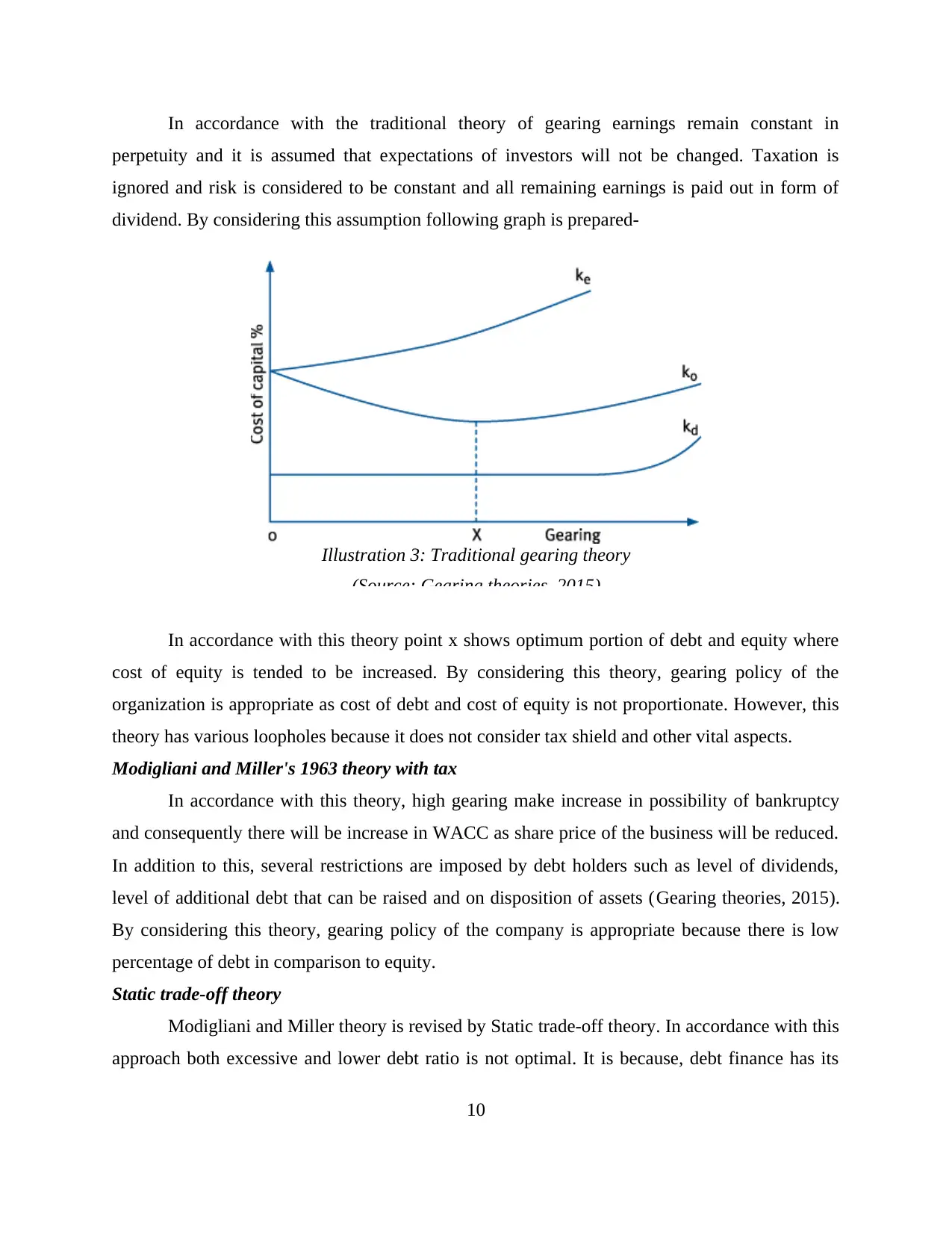
In accordance with the traditional theory of gearing earnings remain constant in
perpetuity and it is assumed that expectations of investors will not be changed. Taxation is
ignored and risk is considered to be constant and all remaining earnings is paid out in form of
dividend. By considering this assumption following graph is prepared-
In accordance with this theory point x shows optimum portion of debt and equity where
cost of equity is tended to be increased. By considering this theory, gearing policy of the
organization is appropriate as cost of debt and cost of equity is not proportionate. However, this
theory has various loopholes because it does not consider tax shield and other vital aspects.
Modigliani and Miller's 1963 theory with tax
In accordance with this theory, high gearing make increase in possibility of bankruptcy
and consequently there will be increase in WACC as share price of the business will be reduced.
In addition to this, several restrictions are imposed by debt holders such as level of dividends,
level of additional debt that can be raised and on disposition of assets (Gearing theories, 2015).
By considering this theory, gearing policy of the company is appropriate because there is low
percentage of debt in comparison to equity.
Static trade-off theory
Modigliani and Miller theory is revised by Static trade-off theory. In accordance with this
approach both excessive and lower debt ratio is not optimal. It is because, debt finance has its
10
Illustration 3: Traditional gearing theory
(Source: Gearing theories, 2015)
perpetuity and it is assumed that expectations of investors will not be changed. Taxation is
ignored and risk is considered to be constant and all remaining earnings is paid out in form of
dividend. By considering this assumption following graph is prepared-
In accordance with this theory point x shows optimum portion of debt and equity where
cost of equity is tended to be increased. By considering this theory, gearing policy of the
organization is appropriate as cost of debt and cost of equity is not proportionate. However, this
theory has various loopholes because it does not consider tax shield and other vital aspects.
Modigliani and Miller's 1963 theory with tax
In accordance with this theory, high gearing make increase in possibility of bankruptcy
and consequently there will be increase in WACC as share price of the business will be reduced.
In addition to this, several restrictions are imposed by debt holders such as level of dividends,
level of additional debt that can be raised and on disposition of assets (Gearing theories, 2015).
By considering this theory, gearing policy of the company is appropriate because there is low
percentage of debt in comparison to equity.
Static trade-off theory
Modigliani and Miller theory is revised by Static trade-off theory. In accordance with this
approach both excessive and lower debt ratio is not optimal. It is because, debt finance has its
10
Illustration 3: Traditional gearing theory
(Source: Gearing theories, 2015)
Paraphrase This Document
Need a fresh take? Get an instant paraphrase of this document with our AI Paraphraser
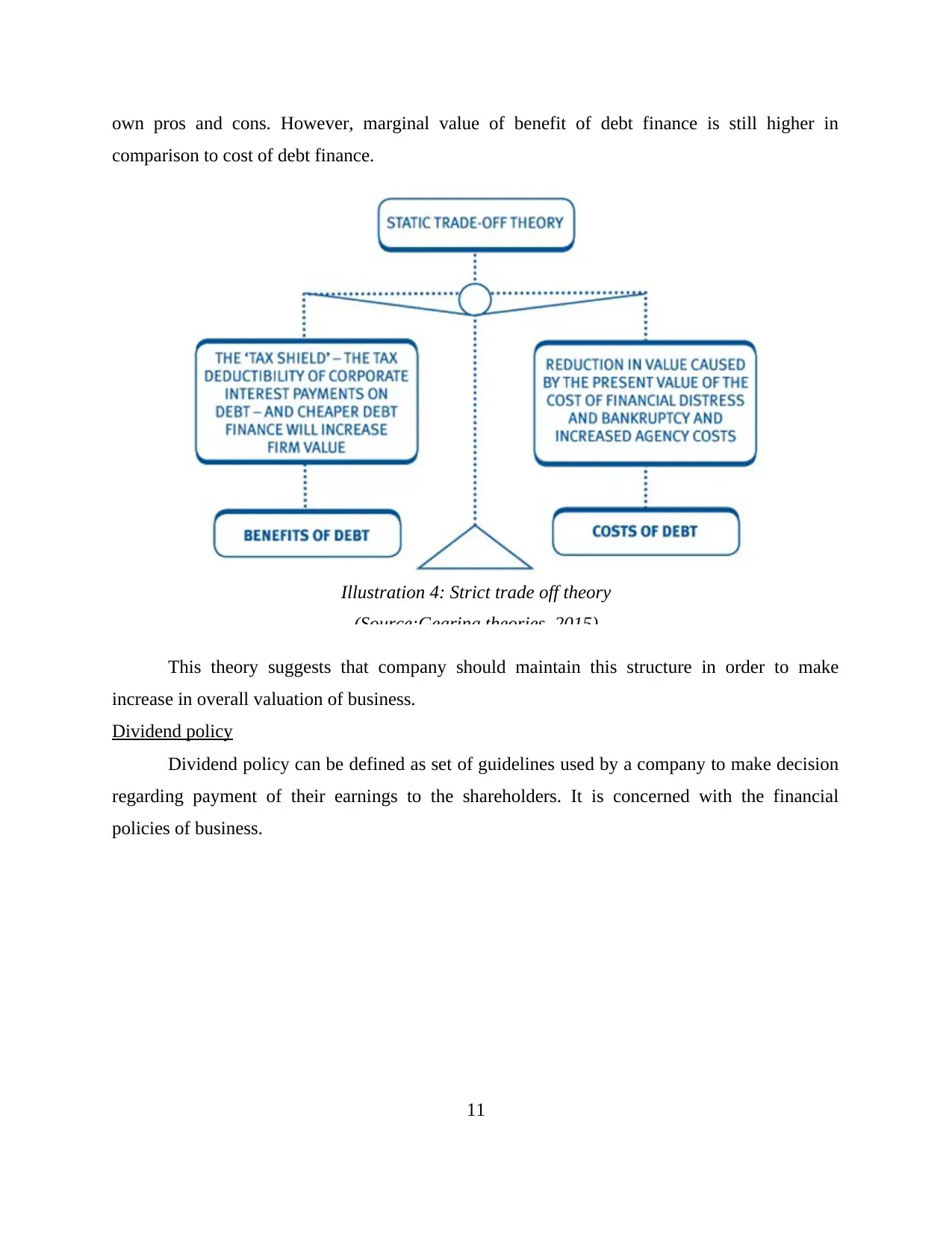
own pros and cons. However, marginal value of benefit of debt finance is still higher in
comparison to cost of debt finance.
This theory suggests that company should maintain this structure in order to make
increase in overall valuation of business.
Dividend policy
Dividend policy can be defined as set of guidelines used by a company to make decision
regarding payment of their earnings to the shareholders. It is concerned with the financial
policies of business.
11
Illustration 4: Strict trade off theory
(Source:Gearing theories, 2015)
comparison to cost of debt finance.
This theory suggests that company should maintain this structure in order to make
increase in overall valuation of business.
Dividend policy
Dividend policy can be defined as set of guidelines used by a company to make decision
regarding payment of their earnings to the shareholders. It is concerned with the financial
policies of business.
11
Illustration 4: Strict trade off theory
(Source:Gearing theories, 2015)
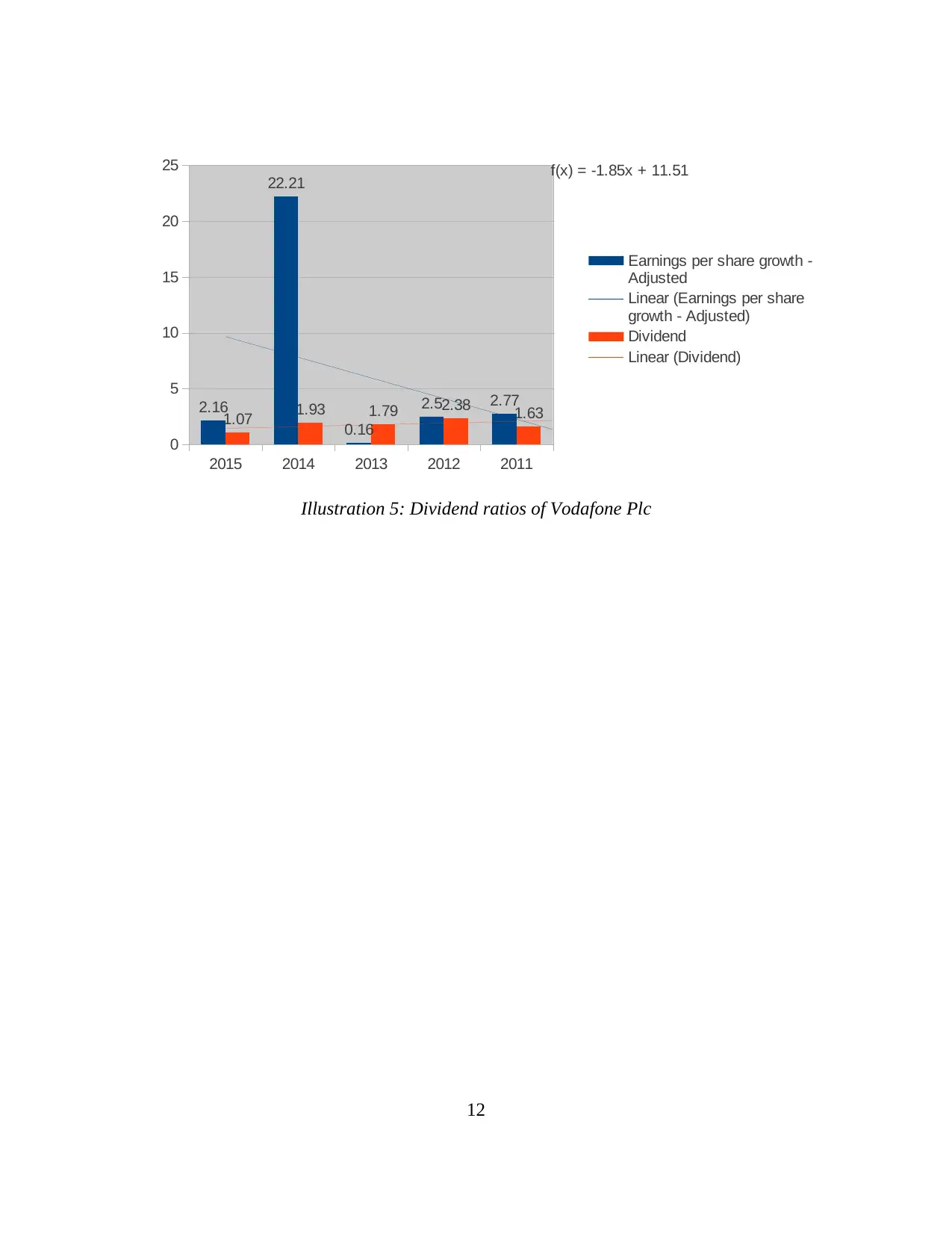
12
2015 2014 2013 2012 2011
0
5
10
15
20
25
2.16
22.21
0.16
2.5 2.77
1.07 1.93 1.79 2.38 1.63
f(x) = -1.85x + 11.51
Earnings per share growth -
Adjusted
Linear (Earnings per share
growth - Adjusted)
Dividend
Linear (Dividend)
Illustration 5: Dividend ratios of Vodafone Plc
2015 2014 2013 2012 2011
0
5
10
15
20
25
2.16
22.21
0.16
2.5 2.77
1.07 1.93 1.79 2.38 1.63
f(x) = -1.85x + 11.51
Earnings per share growth -
Adjusted
Linear (Earnings per share
growth - Adjusted)
Dividend
Linear (Dividend)
Illustration 5: Dividend ratios of Vodafone Plc
⊘ This is a preview!⊘
Do you want full access?
Subscribe today to unlock all pages.

Trusted by 1+ million students worldwide
1 out of 18
Related Documents
Your All-in-One AI-Powered Toolkit for Academic Success.
+13062052269
info@desklib.com
Available 24*7 on WhatsApp / Email
![[object Object]](/_next/static/media/star-bottom.7253800d.svg)
Unlock your academic potential
Copyright © 2020–2025 A2Z Services. All Rights Reserved. Developed and managed by ZUCOL.





